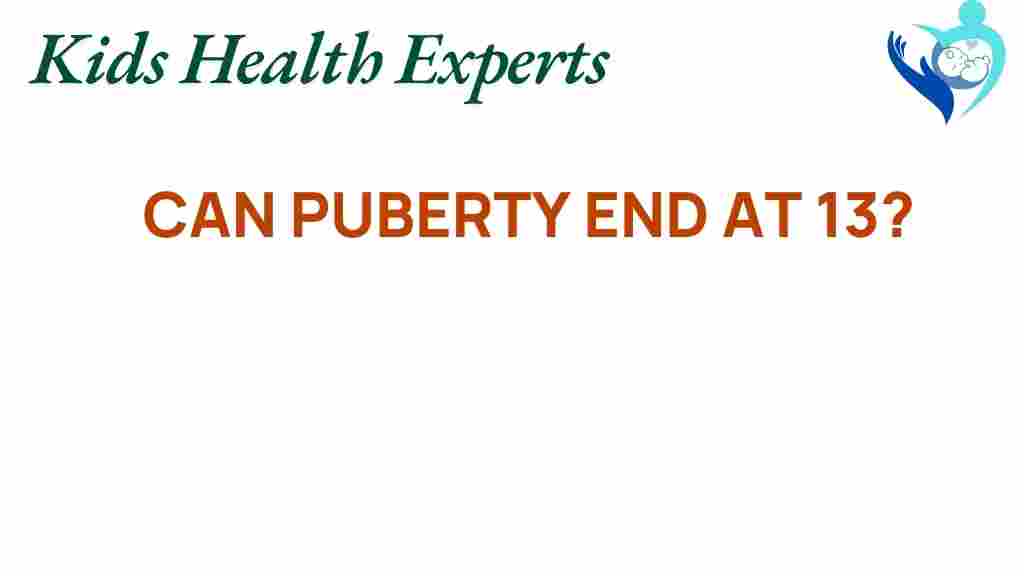The Surprising Truth: Can Puberty Really End at 13?
Puberty is a critical phase in human development, marking the transition from childhood to adolescence. This period is characterized by significant physical, emotional, and hormonal changes that prepare individuals for adulthood. While most people associate puberty with a wide age range, many wonder if it can genuinely conclude as early as 13. In this article, we will explore the nuances of puberty, the factors influencing its duration, and the implications for health and development.
Understanding Puberty
Puberty typically occurs between the ages of 9 and 16 for girls and 10 to 17 for boys. This stage is initiated by the release of hormones such as gonadotropin-releasing hormone (GnRH), which triggers the production of sex hormones like estrogen and testosterone. These hormones are responsible for the various physical changes observed during adolescence, including:
- Growth spurts
- Development of secondary sexual characteristics (e.g., breasts, pubic hair)
- Menstruation in females
- Increased muscle mass in males
- Emotional changes and mood swings
The timing and progression of these changes can vary significantly among individuals, leading to questions about when puberty truly ends and the implications of an early conclusion.
The Developmental Timeline of Puberty
To better understand whether puberty can end at 13, it is essential to recognize the typical developmental timeline:
- Early Adolescence (Ages 9-12): This phase is often when the first signs of puberty appear. Girls may start developing breasts and experience their first menstrual cycle, while boys may notice testicular enlargement.
- Mid Adolescence (Ages 13-15): This stage is marked by rapid physical growth and the development of secondary sexual characteristics. Emotional and social changes are also prominent.
- Late Adolescence (Ages 16-19): By this time, most individuals have reached physical maturity. However, some individuals may continue to experience hormonal changes and growth spurts into their late teens.
Based on this timeline, it is clear that while some individuals may complete most physical changes by age 13, the complete end of puberty and development can extend well into the late teen years.
Factors Influencing the Duration of Puberty
Several factors can influence how long puberty lasts and when it may conclude. These include:
- Genetics: Family history plays a crucial role in determining the timing and duration of puberty. If parents experienced early or late puberty, their children may follow suit.
- Nutrition: A well-balanced diet can impact growth and development. Malnutrition may delay puberty, while obesity can lead to earlier onset.
- Health Conditions: Chronic illnesses or hormonal disorders can affect the timing of puberty. Conditions such as Turner syndrome or Klinefelter syndrome can result in atypical development.
- Environmental Factors: Exposure to endocrine disruptors, such as certain chemicals found in plastics, can influence hormonal changes.
Given these factors, it’s crucial to consider that while puberty might seem to end at 13 for some, it is not a universal experience.
The Health Implications of Early Puberty
Ending puberty at 13 can have various health implications. Early onset of puberty is linked with:
- Increased risk of mental health issues, such as anxiety and depression.
- Higher likelihood of engaging in risky behaviors, including substance abuse.
- Potential for chronic health issues later in life, including obesity and cardiovascular diseases.
Thus, while some may complete their physical development early, the emotional and psychological aspects of adolescence continue to evolve well beyond this age.
Common Myths about Puberty
There are many misconceptions surrounding puberty and its timeline. Some of the most common myths include:
- Myth 1: Puberty ends at the same age for everyone.
- Myth 2: Once physical changes are complete, hormonal changes cease entirely.
- Myth 3: Late bloomers are at a disadvantage in life.
It’s essential to debunk these myths to foster a better understanding of growth and development during adolescence.
Step-by-Step Process: How to Support Healthy Development During Puberty
Supporting adolescents through puberty involves several key steps:
- Open Communication: Encourage discussions about the changes they are experiencing. This can help alleviate confusion and promote a healthy understanding of their bodies.
- Healthy Nutrition: A balanced diet rich in nutrients supports growth and hormonal balance. Focus on fruits, vegetables, whole grains, and lean proteins.
- Promote Physical Activity: Regular exercise not only supports physical health but also boosts mental well-being.
- Monitor Health: Regular check-ups with healthcare providers can help address any concerns regarding growth or development.
- Educate on Mental Health: Provide resources and support for managing emotional changes and stress during this time.
By actively engaging in these steps, parents and guardians can help ensure a healthier transition through adolescence.
Troubleshooting Tips: Addressing Concerns During Puberty
It’s common for adolescents and their families to face challenges during puberty. Here are some troubleshooting tips:
- Concern: Delayed puberty.
- Solution: Consult a healthcare provider for a thorough evaluation. Early intervention can address underlying health issues.
- Concern: Emotional distress or mood swings.
- Solution: Encourage open dialogue and consider seeking support from a mental health professional if needed.
- Concern: Body image issues.
- Solution: Promote a positive body image through discussions about self-acceptance and the normalcy of diverse body types.
By addressing these concerns proactively, families can navigate the complexities of puberty more effectively.
Conclusion
In conclusion, while some individuals may experience the end of puberty at age 13, this is not the case for everyone. The journey of puberty is highly individualized, influenced by a myriad of factors including genetics, health, and environment. Understanding the developmental timelines and supporting adolescents through this critical period can significantly impact their health and well-being.
For more in-depth information on adolescent health, you can visit the CDC’s Healthy Youth page. Additionally, consider checking out our other articles on adolescent development here.
Ultimately, fostering a supportive environment during this transformative time can help ensure a healthy transition into adulthood.
This article is in the category Growth and created by KidsHealthExperts Team
